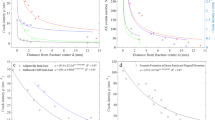Abstract
—Understanding the physics of earthquakes and the space-time patterns they produce is illuminated by the use of coarse-grained models and simulations that capture the basic physical processes, and that are amenable to analysis. We present a summary of ideas that describe the nucleation, growth, and arrest of earthquakes on individual faults. Under shear loading, we find that faults reside in a metastable state near a classical spinodal that governs the nucleation and growth of slip events. The roughness of an associated stress distribution field Σ(x, t) determines whether slip events are confined within the initial high stress patch, or break away and grow to become very large. We find a critical value of roughness that is associated with a first-order, "order–disorder" transition. We also give a number of predictions, examples and applications of these ideas, and indicate how they might be tested through systematic observational programs.
Similar content being viewed by others
Author information
Authors and Affiliations
Additional information
Received August 12, 1998, revised/accepted November 17, 1998
Rights and permissions
About this article
Cite this article
Rundle, J., Klein, W. & Gross, S. Physical Basis for Statistical Patterns in Complex Earthquake Populations: Models, Predictions and Tests. Pure appl. geophys. 155, 575–607 (1999). https://doi.org/10.1007/s000240050278
Published:
Issue Date:
DOI: https://doi.org/10.1007/s000240050278




